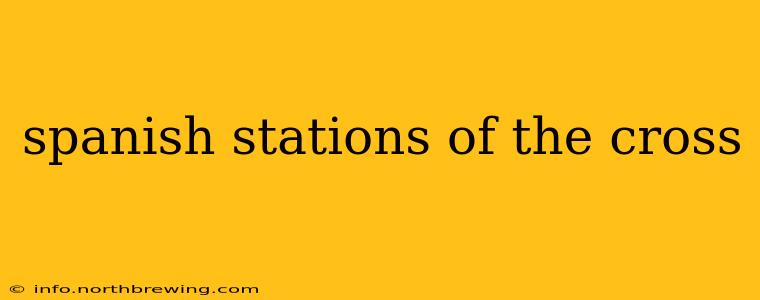The Stations of the Cross, also known as the Via Crucis, is a deeply spiritual devotion practiced by Catholics worldwide. This powerful meditation on the suffering and death of Jesus Christ offers a path to reflection and understanding of his sacrifice. While the Latin text is traditional, many churches and individuals use translations into various languages, including Spanish. This exploration delves into the significance of the Spanish Stations of the Cross, their cultural context, and their enduring relevance.
What are the Stations of the Cross in Spanish?
The Stations of the Cross, when recited in Spanish, maintain the same fundamental narrative as the original Latin. Each station recounts a significant event in Jesus' journey from his condemnation to his crucifixion and burial. The Spanish translations vary slightly depending on the specific translation used, but the core meaning remains consistent. You’ll often find them referred to as "Las Estaciones de la Cruz" or "El Vía Crucis." Many churches will have the Stations depicted visually, often with accompanying Spanish text for each station.
What are the traditional 14 Stations of the Cross in Spanish? (A Brief Overview)
While the exact wording can vary, here's a general overview of the 14 Stations in Spanish, keeping in mind the subtle differences that might exist between different translations:
- Jesús es condenado a muerte (Jesus is condemned to death): Pilate sentences Jesus to death.
- Jesús carga con la cruz (Jesus takes up the cross): Jesus is burdened with the weight of the cross.
- Jesús cae por primera vez (Jesus falls the first time): The physical and emotional weight proves too much.
- Jesús se encuentra con su madre (Jesus meets his mother): A poignant moment of maternal grief and love.
- Simón de Cirene ayuda a Jesús a llevar la cruz (Simon of Cyrene helps Jesus carry the cross): An act of compassion and assistance.
- Verónica limpia el rostro de Jesús (Veronica wipes the face of Jesus): An act of kindness and reverence.
- Jesús cae por segunda vez (Jesus falls the second time): Highlighting the intense suffering Jesus endures.
- Jesús consuela a las mujeres de Jerusalén (Jesus comforts the women of Jerusalem): A moment of empathy and understanding.
- Jesús cae por tercera vez (Jesus falls the third time): Symbolising the ultimate sacrifice.
- Jesús es despojado de sus vestiduras (Jesus is stripped of his garments): A dehumanising and humiliating act.
- Jesús es clavado en la cruz (Jesus is nailed to the cross): The horrific act of crucifixion.
- Jesús muere en la cruz (Jesus dies on the cross): The culmination of his suffering and sacrifice.
- Jesús es bajado de la cruz (Jesus is taken down from the cross): The removal of Jesus' body from the cross.
- Jesús es puesto en el sepulcro (Jesus is laid in the tomb): The final resting place before resurrection.
How are the Spanish Stations of the Cross used in prayer and reflection?
The Spanish Stations of the Cross are used in much the same way as in other languages. They provide a framework for prayer, meditation, and reflection on the passion and death of Jesus. Individuals or groups may walk the stations, pausing at each one to pray, read scripture, or simply contemplate the events depicted. The use of Spanish allows for a deeper connection for Spanish speakers, grounding the experience in their native tongue and cultural context.
Are there different versions of the Stations of the Cross in Spanish?
While the core narrative remains consistent, variations exist in the phrasing and specific details within Spanish translations. Different dioceses or religious orders might have slightly different preferences in their wording. The overall meaning, however, consistently focuses on the suffering, sacrifice, and ultimate triumph of Jesus.
Where can I find Spanish Stations of the Cross prayers?
Many websites and prayer books offer Spanish translations of the Stations of the Cross. Additionally, many Catholic churches that predominantly serve Spanish-speaking communities will have the Stations displayed with Spanish text. Searching online for "Estaciones de la Cruz en Español" or "Vía Crucis en Español" will yield numerous results.
This exploration provides a comprehensive overview of the Spanish Stations of the Cross, answering common queries and shedding light on its significance for Spanish-speaking Catholics. The Via Crucis remains a powerful tool for spiritual reflection, offering solace and strengthening faith regardless of language.
